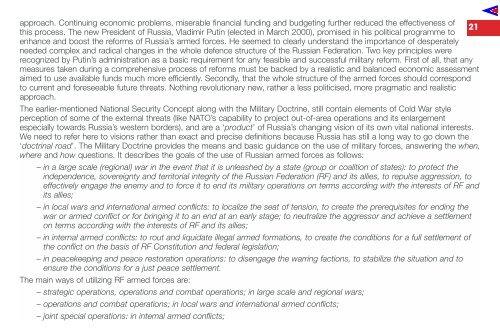Volume 4 No 4 - Air Power Studies
Volume 4 No 4 - Air Power Studies
Volume 4 No 4 - Air Power Studies
Create successful ePaper yourself
Turn your PDF publications into a flip-book with our unique Google optimized e-Paper software.
approach. Continuing economic problems, miserable financial funding and budgeting further reduced the effectiveness of<br />
21<br />
this process. The new President of Russia, Vladimir Putin (elected in March 2000), promised in his political programme to<br />
enhance and boost the reforms of Russia’s armed forces. He seemed to clearly understand the importance of desperately<br />
needed complex and radical changes in the whole defence structure of the Russian Federation. Two key principles were<br />
recognized by Putin’s administration as a basic requirement for any feasible and successful military reform. First of all, that any<br />
measures taken during a comprehensive process of reforms must be backed by a realistic and balanced economic assessment<br />
aimed to use available funds much more efficiently. Secondly, that the whole structure of the armed forces should correspond<br />
to current and foreseeable future threats. <strong>No</strong>thing revolutionary new, rather a less politicised, more pragmatic and realistic<br />
approach.<br />
The earlier-mentioned National Security Concept along with the Military Doctrine, still contain elements of Cold War style<br />
perception of some of the external threats (like NATO’s capability to project out-of-area operations and its enlargement<br />
especially towards Russia’s western borders), and are a ‘product’ of Russia’s changing vision of its own vital national interests.<br />
We need to refer here to visions rather than exact and precise definitions because Russia has still a long way to go down the<br />
‘doctrinal road’. The Military Doctrine provides the means and basic guidance on the use of military forces, answering the when,<br />
where and how questions. It describes the goals of the use of Russian armed forces as follows:<br />
– in a large scale (regional) war in the event that it is unleashed by a state (group or coalition of states): to protect the<br />
independence, sovereignty and territorial integrity of the Russian Federation (RF) and its allies, to repulse aggression, to<br />
effectively engage the enemy and to force it to end its military operations on terms according with the interests of RF and<br />
its allies;<br />
– in local wars and international armed conflicts: to localize the seat of tension, to create the prerequisites for ending the<br />
war or armed conflict or for bringing it to an end at an early stage; to neutralize the aggressor and achieve a settlement<br />
on terms according with the interests of RF and its allies;<br />
– in internal armed conflicts: to rout and liquidate illegal armed formations, to create the conditions for a full settlement of<br />
the conflict on the basis of RF Constitution and federal legislation;<br />
– in peacekeeping and peace restoration operations: to disengage the warring factions, to stabilize the situation and to<br />
ensure the conditions for a just peace settlement.<br />
The main ways of utilizing RF armed forces are:<br />
– strategic operations, operations and combat operations; in large scale and regional wars;<br />
– operations and combat operations; in local wars and international armed conflicts;<br />
– joint special operations: in internal armed conflicts;
















